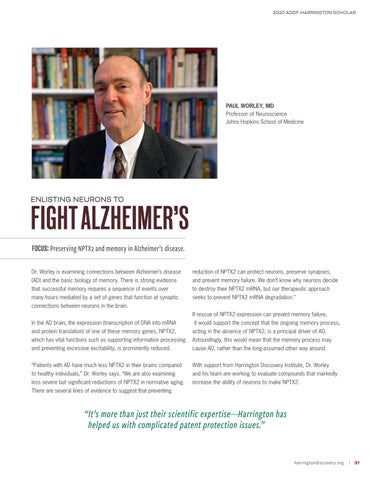2020 ADDF-HARRINGTON SCHOLAR
PAUL WORLEY, MD Professor of Neuroscience Johns Hopkins School of Medicine
ENLISTING NEURONS TO
FIGHT ALZHEIMER’S FOCUS: Preserving NPTX2 and memory in Alzheimer’s disease. Dr. Worley is examining connections between Alzheimer’s disease
reduction of NPTX2 can protect neurons, preserve synapses,
(AD) and the basic biology of memory. There is strong evidence
and prevent memory failure. We don’t know why neurons decide
that successful memory requires a sequence of events over
to destroy their NPTX2 mRNA, but our therapeutic approach
many hours mediated by a set of genes that function at synaptic
seeks to prevent NPTX2 mRNA degradation.”
connections between neurons in the brain. If rescue of NPTX2 expression can prevent memory failure, In the AD brain, the expression (transcription of DNA into mRNA
it would support the concept that the ongoing memory process,
and protein translation) of one of these memory genes, NPTX2,
acting in the absence of NPTX2, is a principal driver of AD.
which has vital functions such as supporting information processing
Astoundingly, this would mean that the memory process may
and preventing excessive excitability, is prominently reduced.
cause AD, rather than the long-assumed other way around.
“Patients with AD have much less NPTX2 in their brains compared
With support from Harrington Discovery Institute, Dr. Worley
to healthy individuals,” Dr. Worley says. “We are also examining
and his team are working to evaluate compounds that markedly
less severe but significant reductions of NPTX2 in normative aging.
increase the ability of neurons to make NPTX2.
There are several lines of evidence to suggest that preventing
“It’s more than just their scientific expertise—Harrington has helped us with complicated patent protection issues.”
harringtondiscovery.org
|
31








